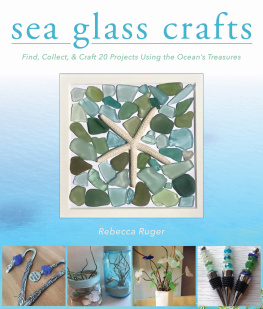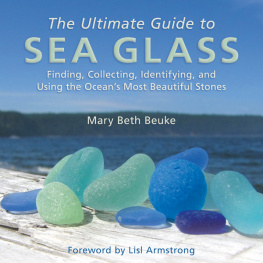
I didnt spot this pottery piece in the pebbles the first time I walked through here.
You might think that all there is to finding sea glass is looking at the sand as you walk along a beach, but that is an oversimplification. These tips will help you spot even small shards you would otherwise miss.
Retrace your steps. Imagine that youre walking along the shoreline, making your way down the beach, taking care to look at the beach thoroughly as you go along. Youre most likely thinking you have covered the area pretty welland you probably havebut then, turn around and walk back through the area youve just searched. Walking in the opposite direction might seem redundant, but it is valuable to change your visual perspective as it relates to the light and the lay of the land. What you see when the light is at your back will be different from what you see when you are facing into the light because of the shadows created by rocks, shells, driftwood, seaweed, and footprints on the beach. The shadows can conceal a shard of sea glass that you could spot when you change your direction.
I always retrace my steps when Im searching, and no matter how many times it happens, I am always shocked when I spot a shard of glass that I missed the first time around. Whether it was the glare from the sun or shadows on the beach that caused me to miss it the first time, the most important thing is that I came home that day with my treasure!
Dont search by looking for colors alone, look for shapes as well. Obviously, when you are beachcombing, you are looking for sea glass mostly by its color. Beautiful aqua and green colors are especially easy to see against the contrasting beige sand. But you will find more treasures by learning to train your eyes to search for shapes. Sea glass isnt always going to be a bright color that stands out, it could be a shade of white, brown, gray, or yellow that blends in with the shells, pebbles, and sand. When thats the case, the shape of the sea glass could catch your eye instead. For instance, when there are a lot of shells or pebbles on the beach (which are mostly a rounded shape), a rectangular or triangular shard will stand out. This is how I made one of my best finds! It was a piece of white pottery that had a faint purple design on its surface, but the beach I was searching was primarily made up of small, perfectly round, white and beige pebbles. A square shape suddenly caught my eye; the square stood out against all the round stones.
Locate the high tide line. When you first arrive at your beach, notice where the high tide mark is. This will give you a visual reference as to how far back from the water to search. The ocean reaches low tide and high tide twice in each 24-hour period. At some point each day, the tide extends onto the beach at a maximum distance for that tidal period. Commonly along this high tide line, the ocean will leave behind a trail of shells or seaweed or both, known as wrack, running perpendicular to the beach as evidence of its reach. Make sure to snoop underneath this beach wrack in case its hiding a beach treasure! Search the entire beach up to the wrack line because sea glass can be deposited anywhere in this area.

The triangular shape of this pottery shard stands out among the rounded stones.


Sea glass can be partially hidden so move along slowly and be observant.
Move slowly. This one may seem obvious, but many people move along the beach at too brisk a pace to be able to notice everything in detail. It can be very tempting to glance at an area and determine that because nothing caught your eye, it is free of treasures. I sometimes catch myself disobeying this rule and need to force myself to pause, breathe in deeply, and relax into the process of beachcombing. You become more observant when you feel relaxed. The reward here isnt always the bringing away of treasures. The meditative and relaxing aspects of beachcombing are treasures too!

Using peripheral vision can help find a tiny treasure such as the blue shard above.
Be aware of the role that peripheral vision plays. Peripheral vision is the part of your vision that occurs beyond the center portion of your gaze. In other words, when we look at something, we see that object that is in our direct line of vision, but we also see much more than that. So in the same way that someone could be watching a child swimming in the ocean and also noticing the lifeguards waving their arms some distance off to the side, we too can be looking at the sand, noticing the rocks and shells in front of us, when a different color or shape catches our attention from off on the side, just barely within our field of vision. I estimate that my peripheral vision has been responsible for as much as 40 percent of my beach finds. All it takes is an awareness of the cues that come to you peripherally and for you to be moving slowly enough to take advantage of its nuances.

Pay close attention to the shadow your body makes. Depending upon the time of day you are on the beach, your own body can make quite a long shadow on the sand, which blocks a portion of your view. You may need to pay closer attention to the shadowed area so that you dont miss anything. remember too that when you have beachcomb with a friend, his or her shadow will also block some of your view, as yours will block theirs.

Early morning is a great time for beachcombing. Normally there are far fewer people on the beach in the early morning hoursa good thing for beachcombing because there are fewer footprints in the sand to obscure your view of treasures. Sea glass can get buried in the sand during high-traffic times, making finding it even harder. I also prefer the quiet of the early-morning hours on the beach; I feel that it is the time that I can take full advantage of the emotional benefit I derive from being at the seashore. For me its the icing on the cake! Maybe it will be for you too.
Dont be discouraged if you arrive on the beach and you notice others who also appear to be looking for sea glass. This may seem like an insignificant point to make, but some avid beachcombers (and you know who you are!) can be extremely competitive. Some beachcombers become too distracted when others are also searching. I have one particular friend who is competitive, and I am convinced that it negatively impacts her technique, causing her to feel agitated, which leads to rushing the process. As a result, often she will not find as much sea glass as I will. And those apparent competitors? The irony is that, most of the time, theyre not looking for sea glass at all.
















